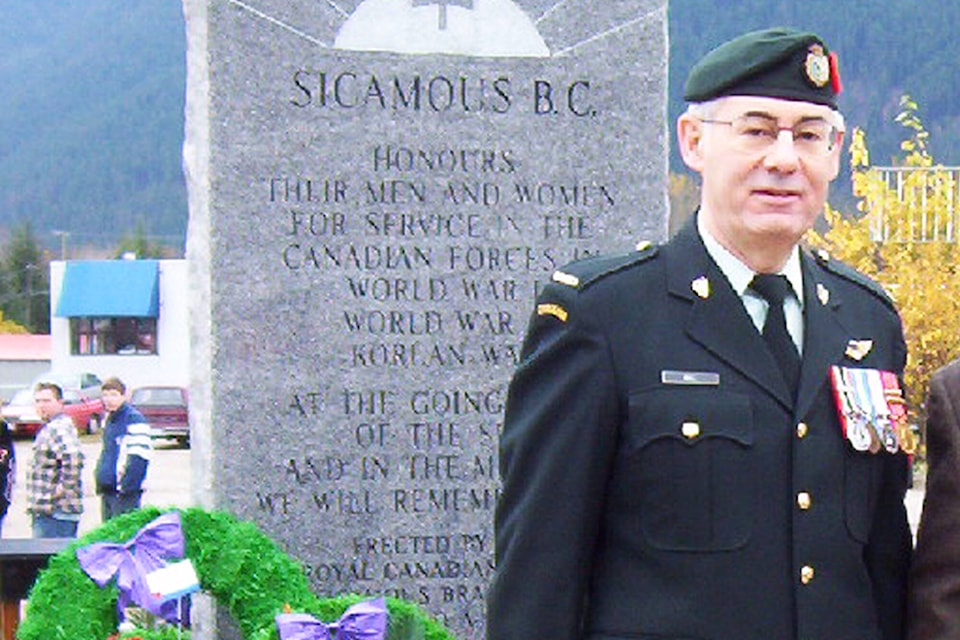By Barb Brouwer
Special to the Observer
Stephen Hill began his military service to Canada in 1958 when he joined the Royal Canadian Army Cadet Corps in Evansburg, Alta.
When he moved to B.C., Hill joined the Rocky Mt. Rangers militia before embarking on a distinguished military career in the Regular Force in 1965.
Hill’s assignments included a tour with the 1st Canadian Signal Regiment, the Canadian Airborne Regiment. He was commanding officer of a communications squadron in Edmonton prior to later becoming the CO of Canadian Forces Station Masset on Haida Gwai. He was posted twice to NATO assignments in Brussels, Belgium.
His single operational tour was adjutant to the commander of the Canadian Airborne Regiment in Cyprus from April to the end of December 1974. The regiment’s task was to separate the warring Turks and the Greek Cypriots.
“We were sent to put a wedge between them,” he said. “It was always called peacekeeping, but it was more like peace-making.”
Hill said when the regiment first arrived on Cyprus they had to wait for the full delivery of needed munitions.
“The battle engagement between the Turks and Greeks erupted without us having time to prepare and we had to wait for the stuff to arrive from Canada,” he said.
On arrival in Nicosia, Hill spent a few nights in the Ledra Palace Hotel, the barracks for the expanded Airborne contingent that provided a buffer to the Greek Embassy, which was located next door.
But the windows of the “palace” had been shot out, there were no bathrooms and when Hill looked at where bullets had strafed the wall, he promptly moved his bed.
When the Turks in their upgraded Korean War Super Sabre aircraft began strafing again, the regimental commander ordered everyone downstairs and said he and Hill would going to the “command cell” located on the other side of the hotel.
Commander Guy Lessard and Hill were shot at several times as they ran across the parking lot.
“Obviously we were entertainment for some Turkish fighters,” he said. “And that’s when I learned you heard the crack of the rifle after the bullet had whizzed by, and several of them did.”
On another occasion, members of the regular Turkish military who had parachuted onto the island earlier, planned to take control of the airport near Nicosia. They were edging their foxhole closer to the airport.
But the airport was under the protection of the Airborne Artillery Battery of the Airborne Regiment, commanded by Maj. Doug Walton.
Read more: In Photos: Sicamous marks Remembrance Day
Read more: Sicamous legion ceremony marks passing of Queen Elizabeth II
“When he saw the Turks moving to launch the attack on the airport, Walton drove his jeep through what the Turks had marked as a minefield,” Hill says. “He drove straight through, with white and United Nations flags, and demanded to speak to the Turkish Commander.”
When the commander arrived, Walton told him he had British Phantom Jets cruising above that were loaded with napalm bombs, which would effectively make a Turkish attack a suicide mission.
When the Turkish commander insisted he had no choice but to carry through the attack, despite the risk, Walton told him he had better get in touch with headquarters in Ankara and ask them to give the order to abort the mission.
“At this point, Doug drove back to his HQ at the Nicosia Airport,” said Hill, pointing out the Turks stood down shortly thereafter.
Hill was in Blue Beret Camp, situated on the other side of the airport in the second line of defence, waiting for the Turks to run through the first line of defence which was Walton’s artillery.
This was the HQ for the entire UN Contingent in Cypress and consisted of soldiers from Sweden, Austria, Canada and others who were deployed throughout the island.
In the event the Turks had made it through the first line of defence, Hill was charged with creating a Final Defence Platoon and given “an assortment” of support staff.
“I was in charge of cooks, supply techs, drivers, mechanics and a postal clerk,” said Hill, noting every person was a soldier first. “Some had come directly out of an infantry background, they are all seasoned soldiers and once they knew we’re getting down to a fight they well-prepared.”
Hill said some adjustments had to be made to sort out who was together in the trenches. Someone who was a bit rusty might have needed someone with more confidence and one possibly trigger-happy soldier could benefit by sharing the trench with someone who could maintain discipline and not shoot before the signal was given.
“We made the decision with the sgt. major who knew the capabilities and personalities of each of the soldiers,” he said, remembering the less sophisticated communication system that was put into place. “They ran out of radios so they had to go back to First World War whistle signals.”
Hill retired in 1998 and is the legion service officer and volunteers within the Sicamous community.
newsroom@saobserver.net
Like us on Facebook and follow us on Twitter
